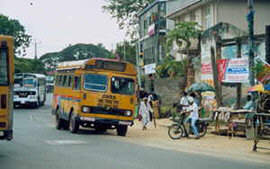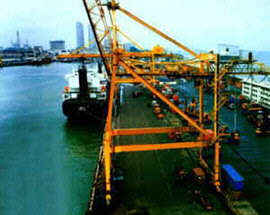 ENCOURAGING PRIVATE INITIATIVES IN TRASPORTATION ENCOURAGING PRIVATE INITIATIVES IN TRASPORTATION |
The Government has enhanced investments into the economic infrastructure of the country, and the private sector has responded favourably to this initiative. Undoubtedly, the transportation sector has benefited from this close cooperation between public and private entities. Lately, passenger transportation showed a certain improvement with moderate expansion in the bus fleet and the number of trains operating. With the intention of increasing the public sector in the passenger sector transport sector to about sixty percent from forty percent, road transport companies continue to expand their fleets and operations.

The Ministry is also involved in the overall policy making of inland water transport, which covers cargo, passenger and ferry services towards certain destinations. Regarding the significant role played by the transport sector in the overall development of the country the Minister of Transport, Hon. Dinesh Gunawardene, comments:
The transport sector has to play a vital role as our economy is becoming more and more industrialized, and priority is given to exports. Export oriented industries have to be moved, and goods as well as the production of raw materials have to be transported in a fast, safe way to their respective destinations. The economy will depend heavily on cargo transport. Nevertheless, passenger transport is also crucial, as without passengers the establishment cannot be run. More capital is required."
Sri Lanka has a trade agreement with the Indian subcontinent, which is the second largest growing economy in Asia today, and consequently according to the Minister of Transport, opportunities in the passenger and cargo transportation are boundless.
From historical days, Sri Lanka had been an important shipping base in the South Asian region, and traders from all parts of the world came here for various trade activities. Economically, the Port, plays a very important role, and among all ports in the country, Colombo in particular. The main focus of the port in recent years, has been on expanding its infrastructure and improving its efficiency, in order to develop the Port of Colombo as a regional hub.

'The country has elaborated plans for the expansion and development of the Port of Colombo and all other ports including Galle, Trincomalee and a new Port (to be built), called Hambantota, which is in the South and even closer to the main shipping route than Colombo', says the Minister of Port Development and Development of the South, Hon. Ronnie de Mel.
The Colombo Port’s two main container terminals: Queen Elizabeth Quay and Jaya Container Terminal are being developed under two development projects. South Asia Gateway Terminals, who also handled cargo while rehabilitating the quay, privatised the Queen Elizabeth Quay in September 1999.
In addition to this, the South Port of Colombo is to be developed too. A feasibility study has already done by a team of consultants from the US, Australia, the Netherlands and Germany. Hon. De Mel says, "We are now looking for the necessary finance to start working on this project in order to have it commenced by January 2003; it will double the present capacity of the Port of Colombo. It will have 12 berths and it will have a new breakwater. It will entail a complete dredging and filling up of areas, terminals and quays. We are planning to call worldwide tenders for the 12 berths." | "We hope that in the future too the private sector will play an important role in the development of the South Port of Colombo and in the general development of the Ports of Sri Lanka. The private sector is entering more and more into the management of Ports in the world and Sri Lanka cannot go against this trend, whether we like it or not," Hon.De Mel says.
The civil aviation sector, which includes air passenger transportation by the national carrier and foreign airlines and related infrastructure development expanded in the past years.
The Aviation and Airport Development Ministry consists of the Department of Civil Aviation, Airports Authority of Sri Lanka Company Limited, and Sri Lankan Airlines.
The country’s only international airport is the Bandaranaike International Airport (BIA). Though the BIA is perceived as a small airport, about three million passengers pass however through the airport in a year. Its facilities are truly international with a well-trained staff and many foreign airlines stop over at BIA to seek technical services and fuelling. Despite the current conflict initiated by the minority group the Tamils, which created certain damages the airport has returned to normal and all the damages are currently in repair. Moreover, the airport authorities are optimistic that this incident will soon be forgotten by the international community, and that the airport will be again a safe destination for business people and tourists alike.
The airport is going through a major development project with the assistance of the Japanese Government, which is aimed at constructing one pier with eight bridges, to further develop the apron facilities, and to expand the terminal building in order to cater to at least five million passengers per year.
"In addition, there will be a new duty free shopping complex with fifty new shops in the arrival area. Sri Lanka offers the most attractive duty free prices and the prices are even cheaper than in Dubai. Several new airports and domestic services are also on the cards," says the Minister of Aviation and Airport Development of Sri Lanka, the Hon. Jeyaraj Fernandopulle.

"We are doing our best to rebuild the country's image as a safe tourist destination and an ideal location for investments. We invite people all over the world to come, visit Sri Lanka and explore opportunities by themselves."
In the transport sector, Sri Lanka's national carrier - Sri Lankan Airlines, which is partly privatised and now managed by Dubai-based Emirates have come a long way since its humble beginnings in 1979 as AirLanka. An airline of the millennium, Sri Lankan was named the 'best airline' in Central Asia at a global competition mid this year.
SriLankan Airline's success in its 21-year history is attributed to its philosophy: always looking to the future, as well as its drive for excellence - be it on the ground or in the air.
As far as image is concerned the most visible change in the airline was its logo. 'It was changed from the traditional red and ivory to a stylish new orange, red and green to project the aspirations of the company as a dynamic, growth-oriented organization,' says Chief Executive Officer of SriLankan Airlines, Peter Hill.
Emirates are in Colombo because they saw a long-term future for Sri Lanka. In the next years Sri Lanka has to concentrate on attracting more tourists and start re-focusing its efforts, not only on the great beaches, but also on the attractions from wild life, natural reserves and, ancient cultural sites.
|

